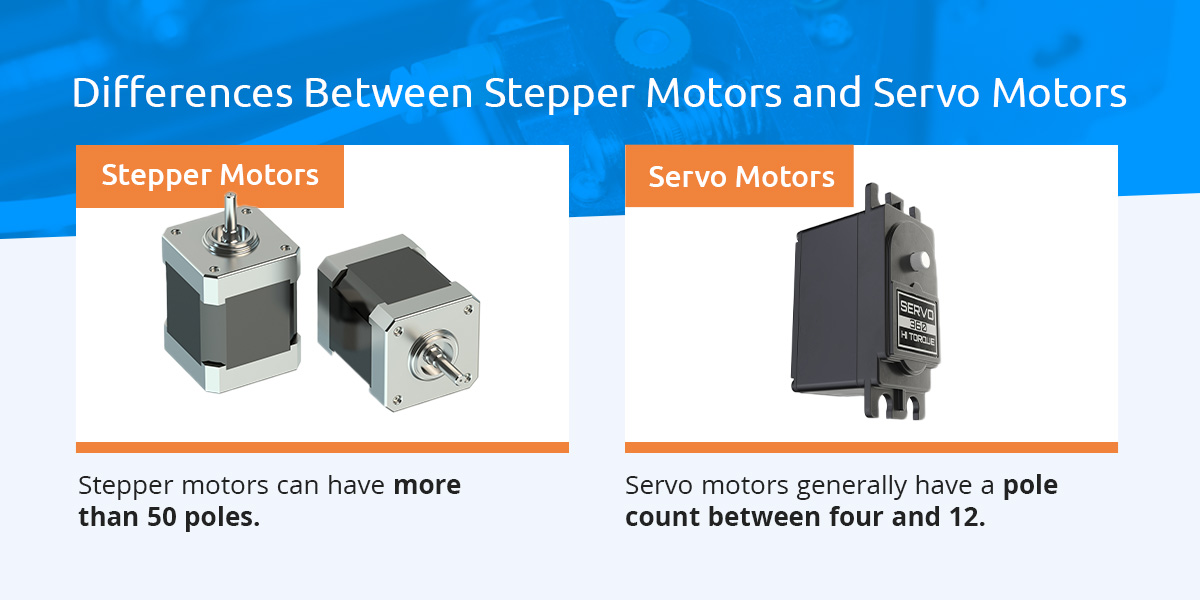Servo Motor vs. Stepper Motor: Key Differences

Selecting the right motor is crucial for boosting team efficiency and meeting application needs. The motor a team uses directly impacts system responsiveness, speed, torque and accuracy.
In manufacturing, two popular motors are steppers and servos, both converting electrical energy into mechanical energy. However, these motors have critical differences, and your team must consider applications and specifications to determine which is suitable.
What Are Stepper Motors and Servo Motors?
There are several fundamental differences between stepper and servo motors. Both motor types utilize permanent magnets in the rotor and need drive circuits for operation. However, each design is unique beyond these similarities, with multiple components impacting compatibility for various applications.
What Is a Servo Motor?
Servo motors have a stationary stator with windings and a rotor with permanent magnets. The currents in these motors create a magnetic field that acts on the rotor to develop torque. These motors operate under closed-loop control and have fewer poles than steppers. Generally, these motors run much faster than the alternative, and speeds can reach several thousand revolutions per minute. Additionally, servo motors can deliver consistent torque across the speed range.
These motors do not have holding torques. Their closed-loop operation allows the drive to command the load to remain in specified positions. However, servo motors continually adjust to hold the position for higher accuracy than stepper motors. The motor links to an encoder and relies on feedback to control motion. Improper positioning prompts the controller to send a signal for the motor to continue until it reaches the necessary position.
What Is a Stepper Motor?
A stepper motor also uses a stationary stator that carries windings. Currents run through these windings and generate a magnetic field. This magnetic field interacts with the magnetic field from the rotor to create a turning force.
These motors have high pole counts, often at least 50, with each pole receiving energy from the motor’s driver to turn the rotor in a series of steps. The high pole counts contribute to the appearance of continuous motion and allow the motor to generate high torques at zero speed.
Stepper motors typically run open-loop, which reduces resolver or encoder complexity and cost. Although these motors can generate high torques, as speed increases, the torque falls off. These motors also have unique performance limitations. For example, the motor must break the friction to move the load and start turning. This process can result in the motor turning four or six steps when a command of five steps is necessary.
Major Differences Between Stepper Motors and Servo Motors
The difference in design between these motors leads to significant differences in function. Significant differences to note include:

- Pole count: Servo motors generally have a pole count between four and 12. Alternatively, stepper motors can have more than 50 poles. Due to the higher pole counts, motion seems continuous in stepper motors. Servo motors require encoders for pulse regulation, and the system is more intricate.
- Stop accuracy: Teams can generally expect accurate stops with either motor. However, the manufacturing quality of electrical and mechanical windings impacts stepper motor stop accuracy. Alternatively, servo motors require encoder resolution, proper algorithms and assembly accuracy to ensure stop accuracy.
- High speed performance: Servo motors output more torque at specific rpm than steppers, allowing them to achieve higher speed performance. The difference in pole count contributes to this variance. Stepper motors can produce high torque at low speeds, while servo motors maintain constant speed throughout the speed range.
- Efficiency: Stepper motors require full current for operation, but servo motors only pull the required current for the load and motion profile. This current is proportional to temperature, resulting in lower power consumption and increased service life. Steppers cannot deliver this current control because it requires more feedback.
Pros and Cons of Servo vs. Stepper Motors
While the difference between servo and stepper motors may indicate some apparent benefits or drawbacks, it’s important to examine each type to make an informed decision. Both motors have pros and cons, which are crucial for determining which will fit your business applications.
A Closer Look at Servo Motors
There are two primary servo motor types — AC and DC servo motors. AC motors are common in industrial applications, while DC motors are suitable for battery-operated devices. Key benefits of servo motors are:
- Dynamic performance: These motors are ideal for applications needing responsive movements and rapid deceleration and acceleration.
- High accuracy: The continuous feedback and closed-loop control of servo motors allow them to deliver positioning consistency and precision.
- Smooth operation: Servo motors offer precise movements at any speed, making them ideal for delicate applications.
- Energy efficiency: Efficient operation across speeds allows servo motors to optimize energy consumption.
- Load resilience: Servo motors can maintain position under varying loads to ensure consistency across applications.
There are also several drawbacks to consider, such as:
- Higher costs: Servo motors are a more expensive initial investment than steppers due to the installation and overall system costs.
- Intricate control: These motors can be challenging to control because teams must establish proportional integral derivative parameters, which can be complicated.
- Tuning requirements: Teams must employ careful tuning to optimize motor stability and performance.
A Closer Look at Stepper Motors
Stepper motors operate on principles of repulsion and electromagnetic attraction. Step angles are a significant consideration, as smaller angles offer higher resolution but often need complex control systems. Some top stepper motor advantages include:
- Open-loop control: The open-loop mode eliminates the need for position monitoring with external feedback sensors, simplifying control and reducing costs.
- Magnetic locking: Steppers can exhibit strong holding torque once energized to prevent slippage or unwanted movement.
- High torque at minimal speed: These motors can provide significant torque at low speeds, making them ideal for applications needing precise control at low speeds.
- Step-by-step movement: These motors ensure precise control and movement with inherent step-by-step motion.
Like servo motors, steppers have some disadvantages. Drawbacks of these motors include:
- Low efficiency: Compared to servo motors, stepper motors have lower efficiency because steppers need substantial power regardless of load.
- Declining torque: As speed increases in stepper motors, torque declines because torque is the inverse of speed.
- Noise levels: Moderate to high speeds can result in louder noises that may be unsuitable for some environments.
Which Is Better: Stepper Motors or Servo Motors?
Ultimately, deciding which motor is better comes down to your business needs. Stepper motors are suitable for applications needing simple motion and no feedback, while servo motors are ideal when sound and vibration must be minimal.
Generally, servo motors are better suited for complex systems that need precise feedback. For example, high accuracy is crucial in CNC machining, making servo motors an excellent solution.
Request a Motor Repair Quote Today
Global Electronic Services offers complete motor repair services. Our years of experience and extensive knowledge ensure high-quality repairs you can count on.
Our services include servo motor repair, hydraulic and pneumatic system maintenance, cleaning and repair services for AC and DC motors, and more. We also conduct thorough inspections after each repair so you can work with confidence.
Request a quote today.

